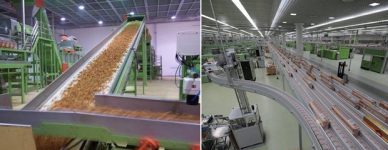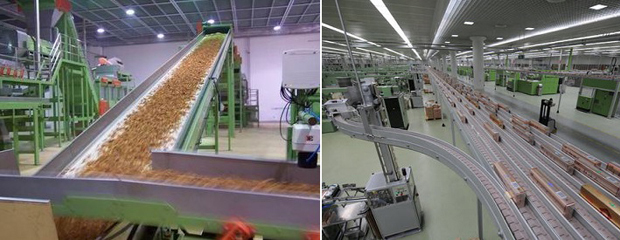
RFID technology helps tobacco logistics
[ad_1]
As an extremely efficient, fast and convenient identification technology, RFID technology has a very wide range of applications in various industries. Cigarette factories introduced RFID technology into the tobacco industry’s logistics system, mainly to improve the efficiency of their tobacco industry’s production and reduce production costs. The application of RFID technology in tobacco logistics.
Using RFID technology, combined with the status quo of tobacco companies. Realize the automation of tobacco storage and the efficient management of the warehouse. The system uses middleware as a supporting platform, attaches RFID tags to cigarette boxes, pallets, and shelves, installs an RFID access control system at the receiving place, and sends the actual receipt and storage information to the back-end upper position, and the back-end system arranges the storage At the same time, install the on-board computer terminal on the forklift, connect the RFID read-write device, and transmit the information of the front-end system and the back-end system through the wireless local area network to realize the exchange and update of data, and the system locates the position of the forklift in real time to facilitate the dispatch of the forklift.
In the entry and exit operations of the three elevated warehouses, a semi-automated method is adopted, and certain automation technology and machinery are introduced, supplemented by manual operations, to achieve a balance between efficiency and cost.
Deploy electronic tags at the bottom of trays and tobacco stem boxes, and deploy readers at sorting lanes, storage entrances, exits, and carton sealing machines correspondingly, combined with the “Tobacco Industry Cigarette Production and Operation Decision Management System Project (i.e. Project No. 1) )”, which can achieve “one sweep and two sweeps”—the cigarette industry enterprises will paste the barcode issued by the competent department on each cigarette produced, and carry out the outbound scan code and the cigarette commercial enterprise inbound scan code, so that Tobacco authorities can timely grasp and implement effective control of the purchase, production, and sales information of tobacco companies, realize information collection and reasonably connect with the warehouse management system, and transmit data information to the warehouse management system for storage through a combination of wired and wireless methods , Analysis and processing, to achieve the goal of rapid and transparent logistics control.
In order to carry out effective positioning, the cargo location must be coded first, and the code information is written into the warehouse management system WMS, generally using address coding.
(1) Warehousing business process design
When raw materials and tobacco auxiliary materials are in the warehouse, use a forklift to put tobacco leaves, tobacco stems, tobacco materials, etc. on the tray with electronic labels, and the reader at the entrance of the warehouse will scan the tray electronic labels on the tray with the coded tray to complete For the matching of pallet information and product information, the matching information is transmitted to the warehouse management system. Then the conveyor sends the goods to the aisle stacker, and the stacker performs the storage operation.
When finished cigarettes are put into storage, they must first be sorted through the sorting channel. Install an RFID reader at each sorting lane, scan the RFID electronic tag on the cigarette box when the cigarette passes through, and quickly identify its type. If it meets the type, push the cigarette into the lane by the side pushing device, and then Palletizing is carried out by an ABB robot. After the palletizing is completed, the conveyor will send the entire pallet to the warehouse, and the RFID reader will scan and record the pallet, and then the conveyor will send it to the stacker station for warehousing. .
The warehouse management system (WMS) determines the storage location of this kind of goods and allocates storage locations based on pre-set storage strategies (such as sorting and random storage), cargo location assignment principles (such as first-in-first-out), cargo inventory status, etc. The information is transmitted to the warehouse control system (WCS), and the warehouse control system drives the conveyor and the lane stacker to complete the warehousing operation.
(2) Outbound business process design
When there is an outbound request, the warehouse management system WMS determines the location of the outbound goods according to the inventory status and outbound rules, and transmits outbound information (such as outbound goods name, quantity, storage location, etc.) to the warehouse control system WCS. The warehouse control system WCS drives the aisle stacker to take out the goods and send them to the outbound station through the conveyor. The RFID reader automatically scans the goods or pallet labels for confirmation and completes the update of the cargo location information. After the error is correct, the shuttle, forklift or AGV trolley Deliver the goods to the designated location. The outbound operation is completed.
After leaving the warehouse, the pallets are manually or automatically sent to the palletizer, the warehouse management system WMS allocates empty spaces to the empty pallet group, and at the same time transmits the information to the warehouse control system WCS, and the warehouse control system WCS drives the conveyor and stacker Send the empty pallet group back to the designated location in the warehouse, and then automatically leave the warehouse for use next time.

RFID and system information quickly interact
(1) Information interaction with WCS system. After uploading the information of materials or pallets through RFID and sending it to the WCS control system, WCS can issue control instructions to specific logistics equipment through PLC. After the logistics equipment receives the control instructions issued by the WCS system, it can accurately transfer The materials or pallets are transported to the designated target location, and then the final confirmation is made by RFID, and the confirmation information is fed back to WCS to complete the information interaction between RFID and WCS system. In this interaction process, RFID played the role of information collection and initiator, and finally as a confirmer and feedbacker, ending this information interaction.
(2) Information interaction with WMS system. After RFID feeds back the information completed with WCS to WCS, WCS transmits the result to WMS, and the indirect information interaction between RFID and WMS is realized through WCS. WMS summarizes and analyzes this information, and then you can understand inventory information, location information, material classification, and the type and quantity of materials that need to be replenished in real time. This information will directly guide the allocation and purchase of materials, and directly affect production. normal operation. Through this information, the WMS system can issue specific instructions to the WCS system to indirectly guide the operation of the equipment.
Therefore, RFID plays a very important role in the entire WCS and WMS system. It is not only the collector of information, but also the confirmer of the final information. It plays a vital role in the entire flow of information. RFID is the core and soul of the warehousing and logistics system of the tobacco industry.
With the help of RFID technology, electronic tags on tobacco leaves, tobacco auxiliary materials, finished products and work-in-products enable production planning managers to quickly locate them and understand the consumption of tobacco leaves and tobacco raw materials, which will greatly improve the efficiency and quality of production; at the same time; RFID technology can also collect and process product information, helping production personnel easily grasp the operation of the entire production line and the production progress of the product. Furthermore, due to the readable and writable nature of RFID, it can provide a continuously updated real-time data stream, which is complementary to the manufacturing execution system. The information provided by RFID can be used to ensure the correct use of labor, machines, tools and components, thereby achieving paperlessness Production and reduce downtime, and promote the smooth progress of production logistics.
Combine RFID with existing manufacturing information systems such as ERP and MES to form a more powerful information chain platform to achieve accurate time and timely delivery of accurate data, so that various online measurements and quality control can be carried out to improve asset utilization. Increase productivity. The use of RFID technology to carry out the overall integration of warehouse management can not only meet the requirements of the distribution operation mode in modern logistics, but also be suitable for large-scale busy logistics distribution to ensure high-quality data exchange in the supply chain; at the same time, by starting from the enterprise production line The tracking and the promotion of transparency in the supply chain can effectively curb or even eliminate extracorporeal circulation, and can play a huge role in tobacco monopoly management.
[ad_2]



